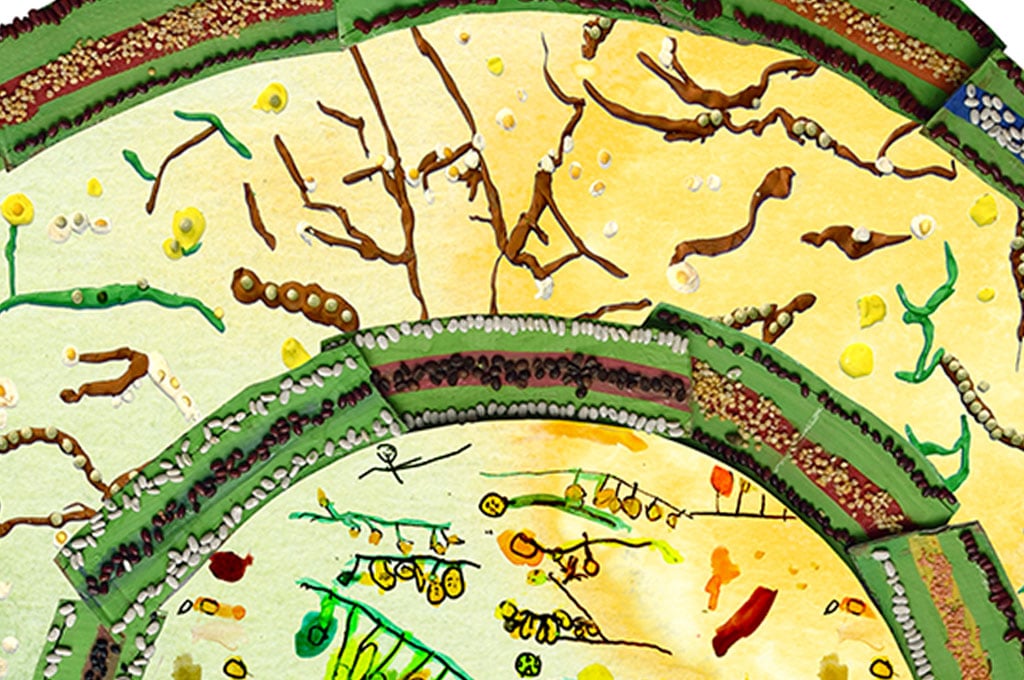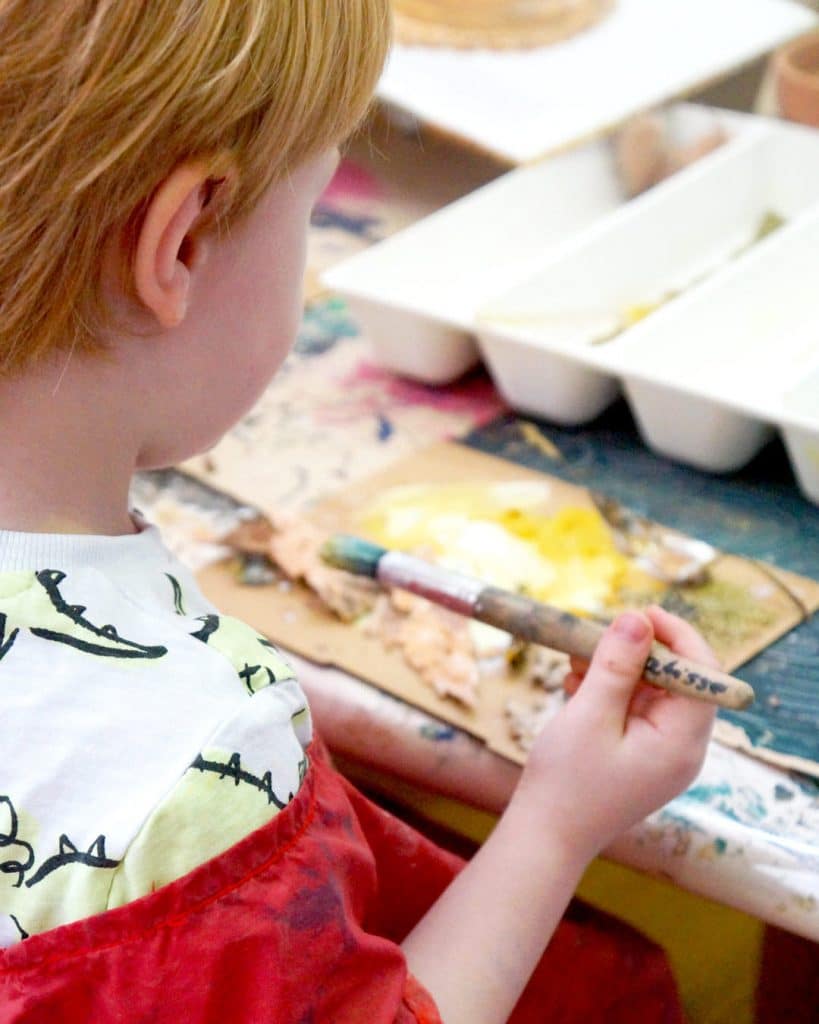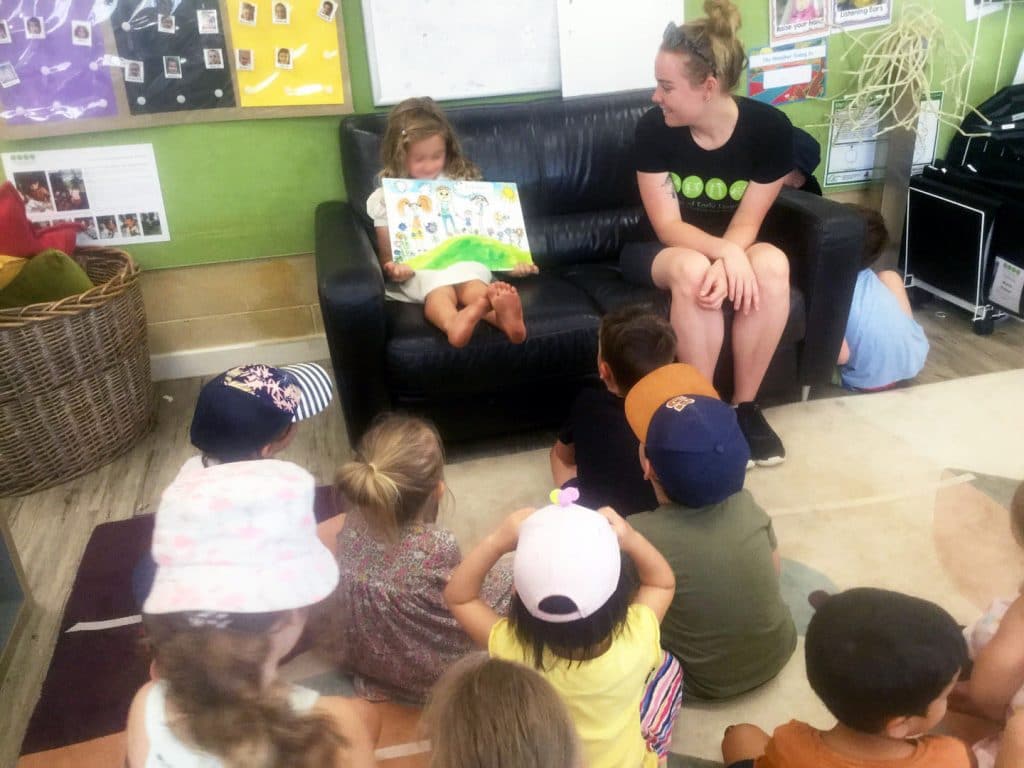At the end of every year at all of our SOEL centres, we hold a large end of year concert for the three and four-year-old rooms.
This event consists of an end of year performance and a gallery of the children’s end of year canvases. Last year we didn’t have an in-person end of year concert, due to this we created the gallery differently.


In order to celebrate the children’s learning, we created a Virtual Art Gallery. This gallery displays the canvases each child created as a culmination of their work. Last year’s research question was ‘Connection to Land and Country’, focusing on the natural world and the six Noongar seasons. Throughout the year the children investigated the seasons with each centre focusing on one for the end of year concert. The children’s learning and understanding of their centre’s season are reflected in the canvases and the dialogue surrounding their creations.
No work sits in isolation. This is key to remember when understanding the bigger picture and recognising the connection between the child’s learning and the culminating canvas. The canvas results from the children’s continuous engagement and revisiting of opportunities that they have had throughout the year.
As co-constructors and facilitators of their thinking, SOEL educators help bring the child’s ideas and thinking to life.
The complex and multi-faceted learning journey leading to the resulting piece is a culminate process. It is a process of provocations, research, explorations, experimentation, engaging with learning environments, interactions, practicing skills, collaboration and revisiting.
The journey and learning process is visible throughout the year within the children’s environments, studio, portfolios and StoryPark. By the time the child arrives to create the portrait, they come with a wide range of understandings, knowledge and ways of seeing the world.


Subiaco SOEL
BIRAK (December to January)
Karella
PRE-KINDY PROGRAMME
In Karella, the children’s canvases encapsulated not only their identity but each of their personal skills developed throughout the year. A Birak colour palette complimented their self-portraits, with a pop of colour on their chosen feature.
Their clay creatures represented their thinking of the unknown. This linked to their investigation of unknown creatures. It also linked to the Big Idea ‘Connecting to Land, Country and Nature’ and their strong connection to the outdoors.
Kanimbla
KINDY PROGRAMME
The Kanimbla children expressed their ideas around their connection to land, Country and nature with birds as a key muse. They did this by using a wealth of mediums and ways of researching. The children selected unique pieces to convey their messages after spending much time compiling, arranging and designing. These pieces are a years’ work of skilling and experimentations of media.
The soft pastel Birak backdrop echoed their research into the six Noongar seasons. Their sculptures and designs offer insight into skill, imagination, and personality. Their family representations highlighted the common idea evident in the children’s explorations, parallels between their family members and the birds.


Como SOEL
BUNURU (February to March)
Poppy & Preston
PRE-KINDY & KINDY PROGRAMME
The children at Como SOEL created their pieces within the context of Images of Me. Images of Me is an investigation into one’s sense of self. Some of the children chose to represent their sense of self through a self-portrait literally. Others drew and painted toys and objects they are fond of, colours they liked, or songs they liked to sing.
The children made creative and representative choices to express this. They drew upon the relationships they had formed and the learning they had grasped. The children were able to choose from a variety of “languages”.
Throughout the year they had learned to become skilled at these “languages”. These included markers, pencil, paper, found objects, imagery, and paint.
For many of the newer children, this piece of work reflected the widening of their secure base. It showed how the children took leaps forward in their confidence and agency. They did this by trying new ways of doing through the creative “languages” on offer.


West Leederville SOEL
DJERAN (April to May)
DaVinci
PRE-KINDY PROGRAMME
Last year the children studied cycles in nature, and the colour transformations from the sky to the waters. This led to a long-term colour mixing exploration, investigating change and transformation throughout the day and through the different seasons.
The transcendent and fluid form of the colours reflected through the sky sparked the children curiosity and sense of wonder. This prompted discussions around how the creatures feel as the sky changes above them and how this affects their behaviours. Do they go to bed like us? Where can they find shelter for the night? Do they need to find their mummy and daddy? Do they stay awake? What do they do? This line of thinking demonstrated their sense of compassion. It highlighted the children’s caring disposition towards all big and small creatures that we share the land with.
The children created a vibrant and unique sunset backdrop for their self-portraits. They did this by applying their observational skills and paint mixing knowledge.
Matisse
KINDY PROGRAMME
Throughout their time at the Schools of Early Learning, the children are given opportunities to explore their sense of self. Not only their physical attributes and personal interests but also the external aspects that influence their identity. These are external aspects such as community and their sense of place.
In the studio, the children are given opportunities to develop their skills in many tools and mediums or “languages”. Through these languages, they explore and creatively express their ideas about their sense of self. Working with each child to create their family portrait educators encouraged them to reflect on their learning throughout the year. They encouraged them to express their unique view of their first community, their family.
As part of their long-term investigation, the children engaged with nature to resource their learning through dialogues with natural materials. Collected locally, the children studied the interconnectedness between shape and form. They used this knowledge to create words, pictures and tell stories. This helped to develop their literacy and numeracy through sequencing, matching, and forming narratives with nature.
Last year, the children chose to incorporate some of the natural elements onto their special End of Year canvas to enhance their shapes and forms and define spaces.


North Perth SOEL
MAKURU (June to July)
Kardan
PRE-KINDY PROGRAMME
Last year, the children of Kardan developed their imaginative skills showing their playful and curious dispositions. Constructing cubby houses allowed for the children to set a scene for narratives. The narratives posed to question our role of belonging within our environments. These narratives were created in collaboration with their peers, fostering relationships.
Adapting and connecting their skills when investigating the Noongar season of Makuru. The children immersed themselves in the Makuru environments, jumping in ‘puddles’, dancing in ‘rain showers,’ and catching ‘raindrops’ in their mouth. Having reflected on their learning journey, the children created a self-portrait, depicting themselves within the season of Makuru.
Wolgol
KINDY PROGRAMME
Last year the children explored their connection with nature, in particular the Noongar season of Makuru. They gained knowledge and formed perspectives whilst developing skills to represent their thinking and understanding. They represented this using a range of tools and mediums, found and natural resources.
During this open-ended journey of exploration, expression and experience, the children immersed themselves in their environment. The children developed a sense of wonder and place as they related to and explored their surroundings. Through storytelling, symbolic and visual representation, dramatic play, music, and dance, they demonstrated a strong interdependence and advocacy for nature.


Nedlands SOEL
DJILBA (August to September)
Bilbies
PRE-KINDY PROGRAMME
Frames are often used in word processing and graphic arts to focus a viewer’s attention. The Bilbies started with this process in a fun and exciting way on their canvas’. They worked with a wet-on-wet technique. They loved to see the colours blend and bleed into each other, racing around in the water on the canvas. This is applied learning using the colour mixing skills they had become familiar with in their Noongar Seasonal representations. For Makuru, nuances of light, dark and grey blues represented the cold, rainy months. In Djilba colours of yellow, greens, orange and red were used with bits of blue representing bursts of rain. The warmer Kambarang was represented in a range of warmer colours, red, orange and yellow.
The self-portraits took shape through exploring preliminary mirror reflections in clay, drawing and painting. Confident with their skills, they draw their impression of themselves over their chosen colour backgrounds. Looking at the portraits, we can see observational expressions and reflective skills. Their work became a window into the children’s thinking, framed on these individualised self-portraits canvas’.
Numbats
KINDY PROGRAMME
The children in Numbats created family portraits. The children explored the composition to represent a place and time of their choice. The children placed figures in composition in preliminary works before they started on our canvas.
Different backgrounds were created using mono-printing. The children experimented with the placement of figures on textured surface areas seeing how that regulates the narrative. Their learning map became more and more detailed but was manifested jubilantly in the family portrait. The children investigated creative solutions when painting their family portraits on a canvas surface. Choosing the right size brush for the size of the area that needs to be painted. Wiping the brush when you wash it after every colour. Wipe it after loading it with the colour nuance suited for the task. Checking the colour on the colour charts to ensure the purity of the colour. Unload some excess paint so that it would not mix into the previously painted colours.
The children also used “tonking” a drying method with folded tissue paper to prevent bleeding. All these methods came together as they created their family portraits.


North Fremantle SOEL
KAMBARANG (October to November)
Kui
PRE-KINDY PROGRAMME
Last year, the Kui children observed changes in nature within their vegetable Garden. They were particularly interested in the transformation of colour in leaves and vegetables as they observed their growth. The children observed flowers within the Noongar Season of Kambarang. They used magnifying glasses and cameras to explore the fine details, theorising about the individual flower’s stories. Using eye droppers, watercolour paints, oil pastels, collage, and markers, the children have made many life representations. They experimented with colour and shared stories about the plants within the season. They identified the impact colour had on the life of a flower or a plant.
Reflecting on portfolio work, Storypark photographs and past experiences, the children shared stories of the vegetable garden and their role. Using many mediums, the children created self-portrait representations of themselves in the space. Each child’s perspective and experience were their own, evident in their unique representations.
Clontarf
KINDY PROGRAMME
The children in Clontarf have created family portraits. These connected their knowledge and skills developed in their investigations of the six Noongar seasons. This final work told a story about their family in Kambarang. These canvases’ result from the children’s continuous engagement and thinking about the opportunities they have had throughout the year. At North Fremantle SOEL the children developed a strong connection to native wildlife.
They studiously researched the kinds of animals that were most active during Kambarang. This was heavily reflected in their end of year canvases. Many families are depicted interacting with animals or have been drawn as animals themselves. The rich dialogue surrounding these canvases shows how much the children have learnt over the year. The educators were proud of the children’s creativity, their engagement, and their eagerness to learn alongside them.
We now invite you to take a look at the canvases the children created and see their learning and understanding for yourselves.




























